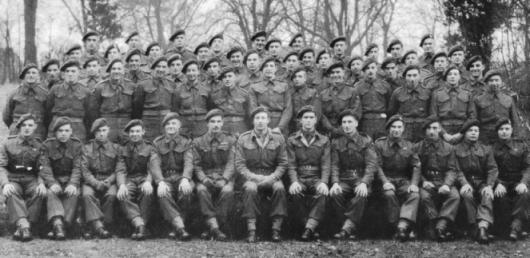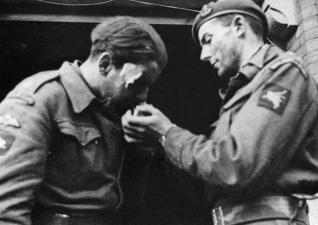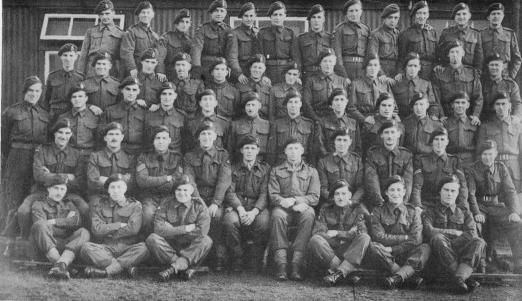
Plate 9. 1st Airlanding Brigade Signal Section(L) - September 1944
(D G Grieve)
Taken in Lincolnshire shortly before the Section left for Arnhem
Click on the plate to enlarge it.
Reorganisation in UK 1944-45
1st Airborne Divisional Signals returned to the Caythorpe area of Lincolnshire. Over the next six months the Unit began to rebuild and retrain. Reinforcements came from new volunteers and some officers were recruited from 21 Army Group. By March 1945 the Unit and the Division were sufficiently reorganised to be ready for an airborne exercise. The Division was now back to a full Division less one parachute brigade which had been replaced in the order of battle by 1st Polish Independent Parachute Brigade.
Throughout this period of reconstruction, contingency plans continued to be developed. Eventually the task given to the Division was quite unexpected.

Plate 10. Two survivors of Arnhem September 1944
Click on the plate to enlarge it.
As the war drew to a close in Europe, orders were received by 1st Airborne Division to prepare to move to Norway. In early May the Division was exercising in Suffolk. On 4 May, 1st Polish Independent Parachute Brigade was ordered to return to its base and to prepare for a deployment overseas. The Brigade was deployed subsequently to Denmark to keep law and order. The remainder of the Division were warned that they would be air lifted to Norway. 1st Parachute Brigade, in the event, deployed to Denmark and was replaced in the Division's Order of Battle by the SAS Brigade.
The Divisional tasks in Norway were to include the maintenance of law and order, the prevention of sabotage to important military and civilian installations and communications and maintenance of the security of operational airfields. In addition, the Division was tasked to ensure that the Germans in Norway observed the terms of the surrender.
This considerable task called for an entirely new signal plan which had to be formulated fairly quickly. Transport aircraft were loaded on 7 May 1945 and the first lift took place on 8 May — VE Day. Divisional HQ deployed to Oslo with one brigade. The remainder of the Division were spread between Stavanger, Bergen and Trondheim.
Before the Division had arrived in Norway, HQ Scottish Command, who had been planning for this contingency, had already contacted the German Commander in Norway to arrange the provision of German equipment to establish certain links. The airborne sets of the Division were totally unsuitable for the task in hand and few were taken. A number of 'suitcase' sets which agents had successfully used, were taken instead. One such set provided communications back to the UK from Oslo shortly after arrival.
It had been decided that the Germans should provide most of the Division's wireless and line communications and a Joint Signals Committee was established to co-ordinate all the resources. The Germans co-operated in this project after overcoming their initial hesitation. A Military HQ was soon established in a large office building in the centre of Oslo and a German 20 position military switchboard was installed in the building. The exchange was manned by an equal number of German airwomen, Norwegian civilian women and Royal Signals airborne operators. By careful arrangement of the shifts, calls in any of the three languages could be handled. German teleprinters were later installed in the building and operators were provided by HQ Scottish Command.
1st Airborne Divisional Signals faced many problems and challenges in the weeks of May. The Division saw the return of the King of Norway and the Norwegian Government to their country. However, HQ Allied Land Forces Norway took over control of the country from HQ 1st Airborne Division at the end of May. Gradually the tasks undertaken by Divisional Signals were handed over to a signal unit that had been formed by HQ Scottish Command and which included Norwegian troops.
The Division remained in Norway until August 1945. Main HQ 1st Airborne Division closed in Oslo at 1800 hours on 25 August. It reopened again at Longford Castle, near Salisbury in Wiltshire. The Divisional Signals also moved back to UK in the second half of August. The unit returned to Caythorpe and a few weeks later moved down to Whiteparish, some 8 miles to the South-East of Salisbury.
Disbandment 1945 It had originally been planned that 1st Airborne Division should become the Imperial Strategic Reserve on the surrender of Germany. Similarly, 6th Airborne Division was earmarked for deployment to the Far East. The surrender of the Japanese on 15 August 1945, however, put paid to that plan. It was subsequently decided that 6th Airborne Division should be retained in the post-war order of battle of the British Army as the Imperial Strategic Reserve and that 1st Airborne Division should disband.
6th Airborne Division was ordered to deploy to Palestine and movement started in mid September. Those men in 1st Airborne Divisional Signals who were not due for early discharge were quickly transferred to 1st Airborne Divisional Signals to make the unit up to strength. The winding up of 1st Airborne Divisional Signals was complete by mid November and the Division disbanded on 15 November 1945 in the Salisbury area. The spirit and traditions of Airborne Signals, however, were far from dead. 6th Airborne Divisional Signals were about to open another chapter in their history - this time in a new role in Palestine.
Redeployment of 1st Parachute Brigade Signal Section
When 1st Airborne Division was deployed to Norway at the end of the war, 1st Parachute Brigade deployed independently to Denmark. The Brigade returned to England in the late summer of 1945 and was placed in reserve. The remainder of 1st Airborne Division were at this stage preparing to disband.
In April 1946 however 1st Parachute Brigade was deployed to Palestine to join 6th Airborne Division. This move resulted from a reorganisation of 6th Airborne Division which in future was to consist of three parachute brigades. The Signal Section for 1st Parachute Brigade was found in the main from men of 1st Airborne Divisional Signals.

Plate 11. 2nd Parachute Brigade Signal Section(K) October 1942
Click on the plate to enlarge it.